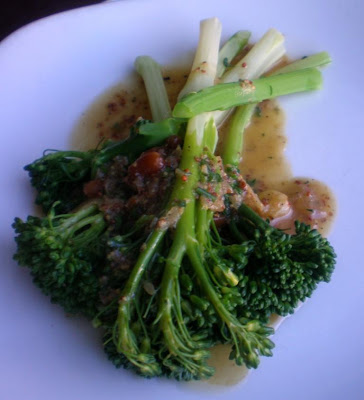Its personality differs from the curries of India, Pakistan, and Malaysia. The best version I have found is at Kubo's Cafe in the Bellaire Chinatown.

Is it curry or is it roux?
The word "curry" is confusing. In Japan, there is a distinction between curry sauce and roux. The roux is the base and is often as simple as curry powder and flour cooked in oil. The roux is then used to make a curry sauce which includes other, chunkier, ingredients like meat or potatoes.
Yet every version of Japanese "curry rice" that I ordered in the U.S. serves only the roux. Other ingredients -- rice, pickled vegetables and someimes a side protein -- are served on the side. At Kubo's, you can order just curry rice, or curry sauce with beef, chicken, pork katsu, or shrimp tempura.
Curry with Japanese personality
Curry came to the Japanese via the Europeans, not from India. So you might look at Japanese curry as a dumbed-down, milder version of an Indian curry that appeals to an audience afraid of too much spice.
But that is not how I look at it. Sure, the personality of Japanese curry couldn't be more different from the Malaysian dry curry I described in part 1. But the personality seems inherently Japanese.
The texture is smooth and delicate, almost creamy. There are no lumps. The roux is, more than anything else, consistent.
The flavors are beefy, mustardy, and slightly spicy. Yet no one flavor stands out. And every bite tastes exactly the same.
The flavor is unified, and distinctive. If you did a blindfolded tasting of curries from 10 countries, the Japanese version would be easy to identify.
This curry makes sense in light of the Japanese aesthetic, which values simplicity and an almost obsessive pursuit of perfection.
Why do I like it so much?
I should prefer the intense spice, variety, and earthy grittiness of the Malaysian curry. But something about Japanese curry is more comforting, almost addictive.
Perhaps it is the texture, almost exactly like my East Texan grandmother's cream gravy. But it also has something to do with that distinctive Japanese curry flavor.
Unfortunately, Japanese curry rice has been hard to find in Houston. Most Japanese restaurants don't serve it -- since it isn't sushi. I became addicted to it 18 years ago in Boston, and have had a hard time finding it here ever since. Fortunately, Kubo's Cafe now serves 6 varieties, all with that same roux.
If you like some heat, like I do, make sure you get one of the small red tubes containing Japanese crushed pepper. Ten or so dashes of pepper it just as hot as a curry from India or Pakistan.
And nothing beats a spicy, smooth gravy.
Next: Thai Curry













